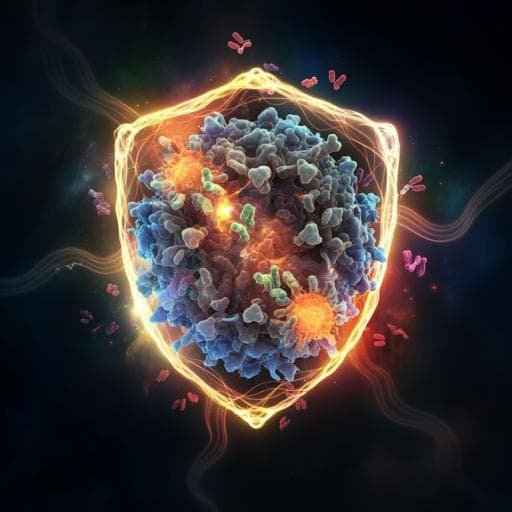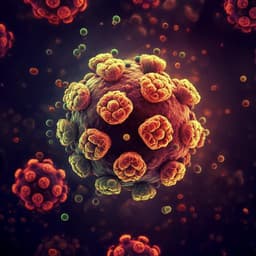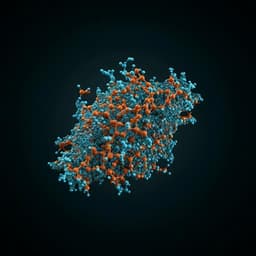
Medicine and Health
Variant-proof high affinity ACE2 antagonist limits SARS-CoV-2 replication in upper and lower airways
M. Gagne, B. J. Flynn, et al.
This groundbreaking study explores the innovative use of aerosolized RBD-62 to combat SARS-CoV-2 Delta in rhesus macaques, demonstrating its ability to suppress viral replication while preserving immune responses. Conducted by a team of expert researchers, this work offers proof-of-concept for novel therapeutics that could prevent severe illnesses from emerging variants.
~3 min • Beginner • English
Introduction
The ongoing emergence of SARS-CoV-2 variants has reduced the effectiveness of vaccines, booster strategies, monoclonal antibodies, and antivirals due to immune escape and potential drug resistance. While boosting can transiently restore protection, benefits beyond certain doses are unclear, and immune imprinting may limit gains from variant-matched vaccines. Current antivirals such as molnupiravir and nirmatrelvir/ritonavir can reduce severe COVID-19 but face challenges including reduced real-world effectiveness, limited prescribing, and the potential for resistance mutations in the viral main protease. There is an urgent need for variant-agnostic therapeutics that act without directly targeting viral proteins to minimize selective pressure and preserve efficacy across evolving strains. The authors previously engineered RBD-62, a soluble protein derived by in vitro evolution of the SARS-CoV-2 receptor-binding domain to increase affinity for ACE2 approximately 100-fold (16 pM vs 1700 pM for wild-type RBD). In vitro, RBD-62 blocks ACE2–spike interactions and inhibits infection at picomolar concentrations, and showed protection in a hamster model. The present study tests the hypothesis that aerosolized RBD-62 can suppress replication of a highly pathogenic variant (Delta) in a nonhuman primate model while allowing development of adaptive immunity and avoiding anti-drug responses.
Literature Review
The paper situates the work within evidence that SARS-CoV-2 variants, particularly Omicron sublineages, have reduced sensitivity to vaccine-elicited antibodies and to previously authorized monoclonal antibodies. Clinical antivirals such as nirmatrelvir/ritonavir reduce severe disease but face potential resistance, and real-world effectiveness may be lower than initial estimates. Prior research has explored ACE2-based decoy strategies and engineered molecules to block spike–ACE2 interactions with varying potency and breadth. The authors’ prior in vitro evolution of RBD yielded RBD-62 with markedly enhanced ACE2 affinity and in vitro neutralization, motivating evaluation in a stringent primate model against Delta. The review underscores the need for host-targeted, variant-agnostic approaches that avoid the pitfalls of antigenic drift and drug resistance seen with virus-targeted interventions.
Methodology
Experimental design: Male Indian-origin rhesus macaques (Macaca mulatta), 2–7 years old, were allocated to RBD-62 treatment or PBS control groups (n=8 per group). Animals were housed under ABSL-2/3 conditions in compliance with NIH IACUC approvals. Challenge virus was SARS-CoV-2 Delta (BEI, NR-56161); animals were challenged with 2 × 10^6 TCID50, with 1.5 × 10^6 TCID50 administered intratracheally (remaining via standard institutional protocol).
Intervention: RBD-62 was formulated in saline (nebulization-compatible) and administered by aerosolization (PARI nebulizer) immediately prior to challenge (day 0) and then every 24 hours for the next 5 days (total of 6 doses), at 10 mg/kg per dose, targeting both upper and lower airways. Controls received PBS (stabilized in gelatin).
Sampling: Bronchoalveolar lavage (BAL) and nasal swabs/washes were collected on days 2, 4, 7, 9, and 14 post-challenge. The first timepoint after treatment cessation was day 7. Animals were followed for 24 weeks for longitudinal virologic and immunologic assessments; necropsy was not performed to preserve longitudinal outcomes.
Virologic assays: Subgenomic RNA (sgRNA; nucleocapsid transcript) was quantified from BAL and nasal samples. Culturable virus was measured by TCID50 (Reed–Muench) on VeroE6-TMPRSS2 cells from BAL and upper airway samples on days 2 and 4. Assay limits of detection were applied; values below LOD were set to half the lower limit for analysis.
In vitro assays: Spike–ACE2 binding inhibition was tested using an MSD V-Plex ACE2 kit across spike proteins from WA1, Delta, Beta, and BA.1 variants, comparing RBD-62, wild-type WA1 RBD, and an irrelevant malaria protein control; IC50/IC90 values were calculated by nonlinear regression in Prism. Infection inhibition assays were performed in VeroE6-TMPRSS2 cells using authentic WA1, BA.1, BA.5, XBB.1.5, and JN.1 variants with serial dilutions of inhibitors; infection was quantified by immunostaining following fixation.
Humoral immunity: Serum, BAL, and nasal wash IgG and IgA binding titers to RBDs (WT, Delta, BA.1), full spike, and nucleocapsid were measured by multiplex assays; results were reported as area under the curve (AUC) or BAU/mL (WHO-standardized) as appropriate. ACE2–RBD binding inhibition in mucosal fluids was assessed after removal of residual RBD-62 by Ni-NTA depletion and dialysis.
Cellular immunity: Intracellular cytokine staining (ICS) in PBMCs and BAL cells assessed CD4+ Th1/Th2, CD8+, and Tfh responses to S1/S2 and nucleocapsid peptide pools; panels included markers for IFN-γ, IL-2, TNF, IL-4, IL-13, IL-21, activation, and Tfh phenotyping.
Memory B cells and anti-drug immunity: Antigen-specific memory B cells were quantified in PBMCs by flow cytometry using fluorochrome-labeled variant spike probes (e.g., WA1, Delta, BA.1) and RBD-62 to determine specificity and cross-reactivity; frequencies within class-switched memory B cells were calculated. Evidence for anti-RBD-62 binding memory B cells was specifically evaluated.
Statistics: Virus titers were analyzed on the log scale; humoral responses analyzed as log-transformed AUC or BAU/mL. Group comparisons at each timepoint used two-sided Wilcoxon rank-sum tests with Holm adjustment across timepoints. R version 4.2.1 was used. Nonlinear regression for IC50/IC90 used Prism (versions 9.3.1/10.2).
Key Findings
- RBD-62 potently inhibits spike–ACE2 binding across variants in vitro: IC50 values for RBD-62 against WA1, Delta, Beta, and BA.1 were all <40 ng/mL, whereas WA1 (wild-type) RBD showed ~330 ng/mL IC50 and failed to achieve 90% inhibition across tested variants at feasible concentrations.
- RBD-62 inhibits authentic virus infection in vitro: In VeroE6-TMPRSS2 cells, RBD-62 blocked infection by WA1, BA.1, BA.5, XBB.1.5, and JN.1 at substantially lower concentrations than wild-type RBD (approximately 100-fold more potent), though higher concentrations were required for infection inhibition than for ACE2-binding inhibition.
- In rhesus macaques challenged with Delta, aerosolized RBD-62 (10 mg/kg pre-challenge and daily for 5 days) significantly reduced viral replication in both lower and upper airways early after challenge:
• BAL sgRNA on day 2: median 2.3 × 10^6 copies/mL (RBD-62) vs 5.5 × 10^8 (PBS), P = 0.0031.
• Nasal swab sgRNA on day 2: geometric mean 2.8 × 10^6 copies/swab (RBD-62) vs 4.5 × 10^7 (PBS), P = 0.0039.
• Culturable virus (TCID50) day 2 BAL: geometric median 1.1 × 10^4 (RBD-62) vs 2.2 × 10^5 (PBS), P = 0.0262.
• Culturable virus day 2 upper airway: 3.6 × 10^6 (RBD-62) vs 1.9 × 10^7 (PBS), P = 0.0404.
- The protective effect waned after cessation of dosing: group differences were not significant by day 7 (first timepoint after treatment ended), though treated animals never reached >10^6 sgRNA copies in either compartment, unlike controls. By day 14, treated animals cleared virus, whereas ~50% of controls still had detectable sgRNA.
- Adaptive immunity developed despite treatment:
• Serum and mucosal IgG/IgA responses to Delta and WT antigens were detected in both groups; treated animals showed delayed kinetics and generally lower magnitude by day 14 compared to controls but still seroconverted.
• Anti-nucleocapsid serum titers at day 14: 11.4 BAU/mL (control) vs 3.5 BAU/mL (RBD-62); BAL anti-N ~0.1 BAU/mL in both.
• ACE2–RBD binding-inhibitory antibodies were detectable in BAL of both groups at low levels (median ~6–8% inhibition in treated animals); nasal wash inhibitory activity was not detected.
- Memory B-cell responses were preserved: Frequencies and cross-reactivity of spike-specific memory B cells (e.g., Delta/WA1 dual binders; BA.1/Delta cross-reactive) were similar between groups at day 14 (e.g., BA.1/Delta cross-reactive geometric mean ~0.14% controls vs 0.13% treated among total memory B cells).
- Minimal anti-drug immunity: Only about 8% of memory B cells specific for RBD-62 and/or Delta bound RBD-62 at day 14 in treated animals, comparable to controls; overall frequencies of RBD-62–binding memory B cells were near pre-challenge background.
- Delivery advantage: Aerosolized RBD-62 reduced replication equivalently in upper and lower airways—an effect often not achieved by systemic or intranasal vaccines in NHPs.
Discussion
The study demonstrates that a host-targeted, variant-agnostic ACE2-binding antagonist (RBD-62) can markedly suppress SARS-CoV-2 Delta replication in both the upper and lower airways of rhesus macaques. This addresses the need for approaches resilient to viral evolution, as RBD-62 does not target mutable viral epitopes but instead competitively occupies host ACE2-binding sites for spike, maintaining potency across diverse variants in vitro. The significant reductions in sgRNA and culturable virus early after challenge, coupled with complete viral clearance by day 14 in treated animals, indicate robust antiviral activity during dosing. Importantly, treatment did not abrogate the development of virus-specific T- and B-cell responses; although primary responses were delayed and often reduced in magnitude, memory B-cell frequencies and cross-reactivity were largely preserved, suggesting the capacity for anamnestic responses upon re-exposure or boosting. The lack of detectable anti-drug memory B-cell responses mitigates concerns about anti-drug immunity limiting repeat use. The observed loss of statistically significant protection after dosing cessation suggests that optimizing dose and/or duration could prolong suppression to clearance without undue immune blunting. Efficient aerosol delivery to both compartments highlights potential utility for pre- or peri-exposure prophylaxis in high-risk exposures (e.g., healthcare settings) and possibly early treatment to reduce transmission. Compared with vaccines requiring prediction of circulating strains and monoclonals prone to escape, this strategy offers a complementary, evolution-resilient tool.
Conclusion
RBD-62, an in vitro–evolved, high-affinity ACE2-binding antagonist, potently inhibits spike–ACE2 interactions across variants and, when aerosolized, significantly suppresses SARS-CoV-2 Delta replication in both the upper and lower airways of rhesus macaques without preventing development of antiviral T- and B-cell immunity or inducing notable anti-drug responses. These findings provide proof-of-concept for a variant-agnostic, host-targeted therapeutic/prophylactic that could complement vaccines and antivirals as SARS-CoV-2 evolves. Future work should optimize dosing and treatment duration, assess post-exposure therapeutic efficacy and transmission impact, explore combination with vaccination (e.g., co-administration to enhance immunity while controlling viral load), and evaluate performance against additional contemporary variants and in diverse host conditions, including immunocompromised settings.
Limitations
- Treatment cessation limited durability of effect; group differences were no longer significant by day 7 (first post-dosing timepoint), suggesting that longer or higher dosing may be required for sustained suppression.
- No pathology or tissue antiviral measurements were obtained due to the longitudinal design keeping animals alive for 24 weeks; thus, tissue-level effects early post-challenge were not assessed.
- Endpoints for post-exposure therapeutic efficacy were not reached, preventing firm conclusions about RBD-62 as a treatment initiated after infection.
- The muted primary immune response in treated animals could, in some contexts, influence protection against reinfection, though memory B-cell preservation suggests protection against severe disease may be maintained via anamnestic responses.
- Findings in male rhesus macaques may not fully generalize to other populations or clinical settings; rebound risk may be higher if treatment is stopped prematurely or in immunocompromised hosts.
- Some mucosal antibody measurements showed low absolute levels and assay limitations (e.g., LOD handling); nasal inhibitory antibodies were not detected.
Related Publications
Explore these studies to deepen your understanding of the subject.







